Nigella
Nigella is a genus of 18 species[1] of annual plants in the family Ranunculaceae, native to Southern Europe, North Africa, South Asia, Southwest Asia and Middle East. Common names applied to members of this genus are nigella, devil-in-a-bush or love-in-a-mist.
| Nigella | |
|---|---|
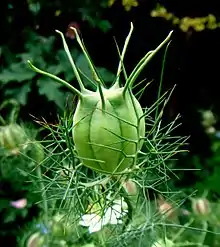 | |
| Nigella damascena seed capsule | |
| Scientific classification | |
| Kingdom: | Plantae |
| Clade: | Tracheophytes |
| Clade: | Angiosperms |
| Clade: | Eudicots |
| Order: | Ranunculales |
| Family: | Ranunculaceae |
| Subfamily: | Ranunculoideae |
| Tribe: | Nigelleae |
| Genus: | Nigella L. |
| Species | |
| |
The species grow to 20–90 cm (8–35 in) tall, with finely divided leaves; the leaf segments are narrowly linear to threadlike. The flowers are white, yellow, pink, pale blue or pale purple, with five to ten petals. The fruit is a capsule composed of several united follicles, each containing numerous seeds; in some species (e.g. Nigella damascena), the capsule is large and inflated.
Uses
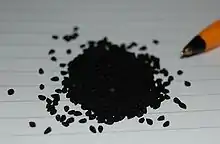
Culinary
The seeds of Nigella sativa, known as kalonji, black cumin, black onion seed, onion seed or just nigella, are used as a spice and a condiment in Pakistani cuisine, Ethiopian cuisine, Middle Eastern and Polish cuisines.[2]
Garden flowers
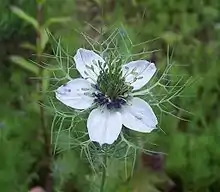
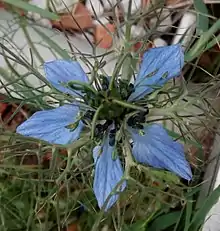
Several species are grown as ornamental plants in gardens. Nigella damascena has been grown in English cottage gardens since the Elizabethan era, commonly called love-in-a-mist. Nigella hispanica is a taller species with larger blue flowers, red stamens, and grey leaves. Nigella seeds are self-sowing if the seed pods are left to mature.
The dried seed capsules can also be used in flower arrangements.
Other
In traditional medicine, the seeds are used as a carminative and stimulant to ease bowel and indigestion problems, and are given to treat intestinal worms, nerve defects, to reduce flatulence, and induce sweating. Dried pods are sniffed to restore a lost sense of smell. It is also used to repel some insects, much like mothballs.
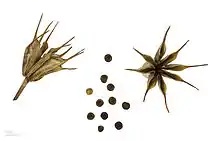
References
External links
![]() Media related to Nigella at Wikimedia Commons
Media related to Nigella at Wikimedia Commons
